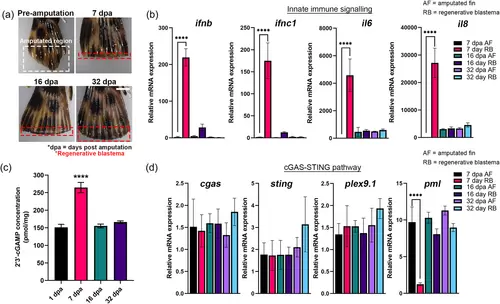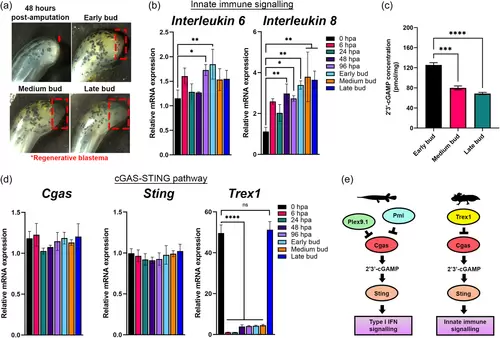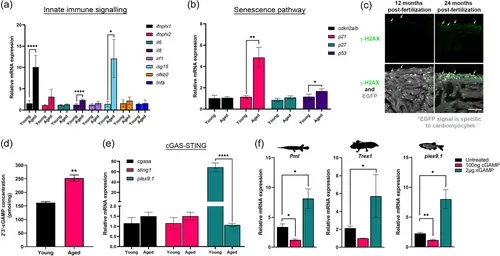- Title
-
Suppressors of cGAS-STING are downregulated during fin-limb regeneration and aging in aquatic vertebrates
- Authors
- Mathavarajah, S., Thompson, A.W., Stoyek, M.R., Quinn, T.A., Roy, S., Braasch, I., Dellaire, G.
- Source
- Full text @ J. Exp. Zool. B Mol. Dev. Evol.
|
Early-stage gar regenerative blastema transition into a pro-inflammatory state with elevated cGAS activity. (a) Spotted gar caudal fins were amputated and regeneration was observed over a 32-day period, with regenerative blastema being collected at the indicated timepoints for molecular analysis. Scale bar indicates 1 cm. (b) Interferons and Interleukins are upregulated in blastema at 7 dpa before returning to baseline levels (n = 3). Gene expression of ifnb, ifnc1, il6 (Interleukin 6), and il8 (Interleukin 8-like) was assessed and significantly different from the original amputated fin (AF) only a 7 dpa. (c) 2′3′- cGAMP levels are elevated specifically at 7 dpa in regenerative blastema. 2′3′-cGAMP concentrations were determined from the same caudal fins used for RNA isolation. (d) Gene expression analysis of cGAS-STING pathway orthologs in gar indicate that pml is downregulated to facilitate immune signaling via the cGAS-STING axis. Variation between groups was assessed with a one-way ANOVA, with Tukey′s post hoc analysis for pairwise comparison between groups. ****p < 0.0001. |
|
Trex1 is downregulated in the limb regenerative blastema of axolotl. (a) Axolotl limbs were amputated at the level of zeugopod and regeneration was observed at different stages of limb regeneration. (b) An increase in the expression of interleukin 6 (Il6) and interleukin 8 (Il8) was observed in the early stages of axolotl limb regeneration. Blastema from the regenerating limb was isolated within the first 96 h and then at three different stages of limb regeneration (early, medium and late bud). (c) 2′3′- cGAMP levels are elevated in the early bud of the regenerating axolotl limb. 2′3′-cGAMP concentrations were determined from the same axolotl regenerative blastema used for RNA isolation. (d) Gene expression analysis of the cGAS-STING pathway orthologs in axolotl indicate that Trex1 is downregulated during the stages of regeneration where cGAS activity is elevated. (e) Comparison of the cGAS-STING pathway in the spotted gar and axolotl. Variation between groups was assessed with a one-way ANOVA, with Tukey's post hoc analysis for pairwise comparison between groups. *p < 0.05; **p < 0.01; ***p < 0.001; ****p < 0.0001 |
|
cGAMP is elevated in hearts from elderly zebrafish and regulates the expression of pml, Trex1, and plex9.1. (a and b) Gene expression analysis of zebrafish hearts from young and aged cohorts shows differences in innate immune signaling markers (a) and senescence markers (b). (c) γ-H2AX foci, a marker of senescence are present in a greater abundance of cells in the hearts of elderly zebrafish. Myocytes were visualized using a tg(myl7:eGFP) reporter that the transgenic animals express. Scale bar is 50 µm. (d) cGAS activity is elevated in the elderly zebrafish. 2′3′-cGAMP concentrations were determined from individual hearts isolated from young and aged zebrafish. (e) Gene expression analysis of the cGAS-STING pathway orthologs in axolotl indicate that plex9.1 expression is reduced in hearts from aged zebrafish. cgasb expression could not be detected in the zebrafish heart samples. (f) Treating cell lines derived from gar (GARL), axolotl (AL1), and zebrafish (ZKS) with cGAMP altered expression of the different cGAS suppressors. Gene expression in zebrafish hearts was compared with an unpaired, two-tailed Student's t-test (two-tailed). Variations between treatment groups was assessed with a one-way ANOVA, with Tukey's post hoc analysis for pairwise comparisons between treatments. *p < 0.05; **p < 0.01; ****p < 0.0001. |



